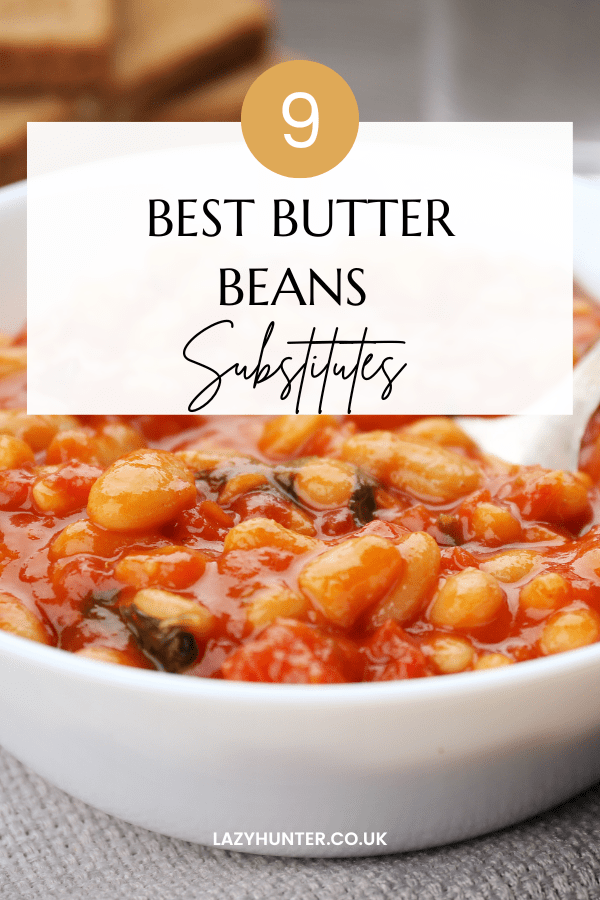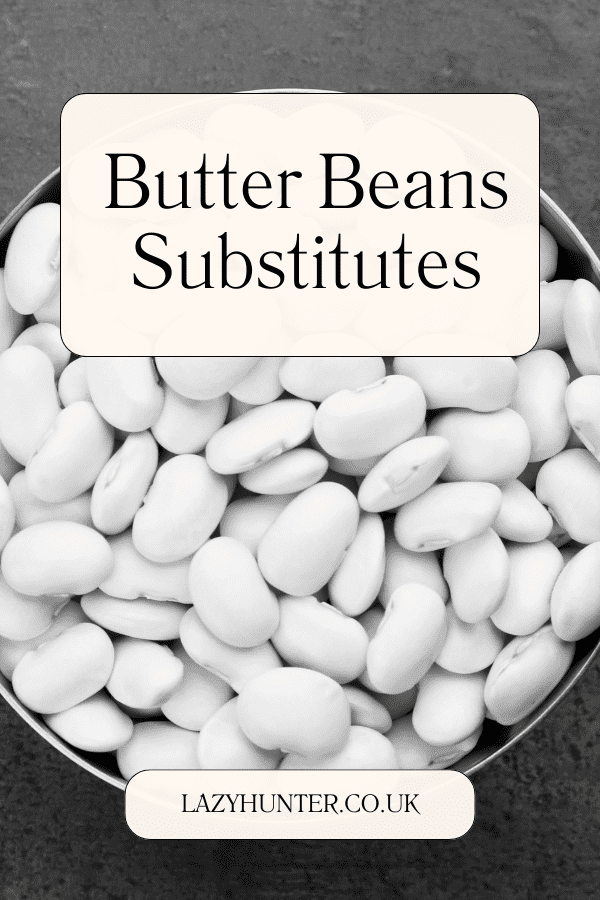Butter beans are an excellent source of protein, fibre, and vitamins. If you’re allergic to or dislike butter beans, chickpeas and black beans are two great substitutes. Chickpeas are versatile and have a nutty flavour, while black beans have a slightly sweet and earthy taste. Both are high in protein and fibre and can be used in a variety of dishes.
Overview of Butter Beans
Butter beans are a type of lima bean that are known for their creamy texture and buttery flavour. They are a popular ingredient in many Southern dishes and are often used in stews, casseroles, and salads.
Nutritional Profile
Butter beans are a good source of protein, fibre, and several essential vitamins and minerals. One cup of cooked butter beans contains approximately:
- 227 calories
- 15 grams of protein
- 15 grams of dietary fiber
- 0.8 grams of fat
- 44 grams of carbohydrates
- 29% of the recommended daily intake of iron
- 18% of the recommended daily intake of magnesium
- 20% of the recommended daily intake of potassium
Culinary Uses
Butter beans are a versatile ingredient that can be used in a variety of dishes. They are often used as a meat substitute in vegetarian and vegan recipes due to their high protein content. They can also be used in soups, stews, and casseroles to add flavour and texture.
Butter beans are also a great addition to salads and can be used in place of chickpeas or kidney beans. They pair well with a variety of flavours, including lemon, garlic, and herbs like thyme and rosemary.
Legume Alternatives
When butter beans are not available or not preferred, several legume alternatives can be used in their place. These substitutes are similar in texture and flavour to butter beans and can be used in a variety of recipes.
Cannellini Beans
Cannellini beans are large, white kidney beans that have a creamy texture and a mild, nutty flavour. They are a popular substitute for butter beans in soups, stews, and casseroles. Cannellini beans are also a good source of protein, fibre, and iron.
Great Northern Beans
Great Northern beans are small, white beans that have a delicate, nutty flavour and a firm texture. They are a good substitute for butter beans in salads, dips, and spreads. Great Northern beans are also a good source of protein, fibre, and potassium.
Navy Beans
Navy beans are small, oval-shaped beans that have a mild, nutty flavour and a creamy texture. They are a popular substitute for butter beans in baked beans, soups, and stews. Navy beans are also a good source of protein, fibre, and iron.
Overall, these legume alternatives are versatile and nutritious substitutes for butter beans. They can be used in a variety of recipes and offer a range of health benefits.
Related
Grain Alternatives
When looking for substitutes for butter beans, grains can be a great option. Chickpeas and lentils are two popular grain alternatives that can be used in a variety of recipes.
Chickpeas
Chickpeas or garbanzo beans are versatile legumes with a nutty flavour and slightly grainy texture. They are a great source of protein, fibre, and several vitamins and minerals. They can be used to make hummus, salads, soups, stews, and even as a crunchy snack.
Lentils
Lentils are a nutritious and versatile grain alternative that can be used in soups, salads, stews, and casseroles. They come in green, brown, and red varieties, each with a slightly different flavour and texture. Lentils are a good source of protein, fibre, and several vitamins and minerals, making them a great substitute for butter beans.
Vegetable Alternatives
Cauliflower
Cauliflower is a versatile vegetable that can be used as a substitute for butter beans in many recipes. It has a mild flavour and a texture that is similar to butter beans, making it an excellent replacement. Cauliflower can be boiled, roasted, or mashed and used in dishes like soups, stews, and casseroles. It is also a great source of fibre, vitamins C and K, and antioxidants.
Potatoes
Potatoes are another vegetable that can be used as a substitute for butter beans. They have a similar texture and can be boiled, mashed, or roasted. Potatoes are a good source of potassium, vitamin C, and fibre. They can be used in dishes like soups, stews, and casseroles.
Potatoes can also be used to make a variety of dishes like potato salad, baked potatoes, and mashed potatoes. They are a versatile ingredient that can be used in many recipes. When using potatoes as a substitute for butter beans, it is important to keep in mind that they have a higher starch content, which can affect the texture of the dish.
Nut and Seed Alternatives
Tahini
Tahini is a paste made from sesame seeds and is a great substitute for butter beans in various recipes. It has a nutty flavor and a creamy texture which makes it an excellent alternative. Tahini is also a good source of protein, healthy fats, and minerals like calcium, magnesium, and iron. It can be used in dips, spreads, dressings, and sauces.
Here is a simple recipe for a tahini-based dip:
- 1/2 cup tahini
- 1/4 cup lemon juice
- 2 cloves garlic, minced
- 1/4 tsp salt
- 1/4 cup water
Mix all the ingredients in a blender until smooth. Adjust the consistency by adding more water if needed. Serve with veggies, crackers, or pita bread.
Sunflower Seeds
Sunflower seeds are another great option as a butterbean substitute. They have a mild nutty flavour and a crunchy texture that can add a nice contrast to dishes. Sunflower seeds are also a good source of protein, fibre, and healthy fats. They can be used in salads, pestos, and dips.
Here is a recipe for a sunflower seed-based pesto:
- 1/2 cup sunflower seeds
- 2 cups fresh basil leaves
- 2 cloves garlic, minced
- 1/4 cup olive oil
- 1/4 tsp salt
- 1/4 tsp black pepper
Pulse the sunflower seeds and garlic in a food processor until finely chopped. Add the basil, salt, and pepper and pulse again. While the food processor is running, slowly pour in the olive oil until the pesto reaches a smooth consistency. Use the pesto as a spread, dip, or pasta sauce.
Related
Preparation Tips for Substitutes
When preparing substitutes for butter beans, there are a few tips to keep in mind to ensure the best results. Here are some helpful preparation tips to consider:
1. Soak the Beans
If you are using dried beans as a substitute for butter beans, it is important to soak them before cooking. Soaking helps to soften the beans and reduce cooking time. To soak the beans, place them in a large bowl and cover them with water. Let them soak for at least 8 hours or overnight. Drain the water before cooking.
2. Adjust Cooking Time
Different substitutes for butter beans may require different cooking times. For example, canned beans may require less cooking time than dried beans. It is important to follow the cooking instructions for the specific type of substitute being used to ensure that they are properly cooked.
3. Seasoning
Butter beans have a mild flavour, so it is important to season substitutes properly to achieve a similar taste. Adding salt, pepper, garlic, and other herbs and spices can enhance the flavour of the substitutes. It is recommended to taste the dish as you add seasonings to ensure the desired flavour is achieved.
4. Texture
Butter beans have a creamy texture that may be difficult to replicate with substitutes. Adding a small amount of cream or pureeing some of the beans can help achieve a creamier texture. It is important to adjust the texture to suit the dish being prepared.
By following these preparation tips, substitutes for butter beans can be used successfully in a variety of dishes.
Health Considerations of Substitutes
When considering substitutes for butter beans, it is important to take into account the health benefits and potential drawbacks of each option. Here are some health considerations to keep in mind:
Nutritional Value
Different substitutes for butter beans have varying nutritional values. For example, lentils are high in protein and fibre, while chickpeas are a good source of iron and folate. It is important to consider the specific nutritional needs of an individual when choosing a substitute.
Allergies and Sensitivities
Some people may have allergies or sensitivities to certain substitutes, such as soybeans or peanuts. It is important to be aware of any allergies or sensitivities when choosing a substitute.
Processing and Additives
Some substitutes may be highly processed or contain additives, which can affect their nutritional value. For example, canned beans may contain added salt, while some meat substitutes may contain preservatives. It is important to read labels and choose substitutes that are minimally processed and contain few additives.
Cooking Methods
How substitutes are cooked can also affect their nutritional value. For example, frying or deep-frying substitutes can add extra calories and unhealthy fats. Steaming, baking, or grilling substitutes can help retain their nutritional value.
By considering these health considerations, individuals can choose substitutes for butter beans that meet their specific nutritional needs and preferences.
Related
- Butter Beans vs Lima Beans: What The Difference
- Butter Beans with Rosemary and Garlic
- Sweet Potato And Chickpea Tikka Masala
- Best Rajma Recipe


